This post may contain affiliate links. Please read our disclosure policy. As an Amazon Associate, I earn from qualifying purchases.
With a crunchy texture and sweet, refreshing flavor, pickled daikon is a great way to elevate any meal! This versatile condiment can go with just about anything- from delicious rice bowls and noodle dishes to salads and sandwiches. Our simple pickled daikon radish recipe makes quick radish pickles that are commonly used in Japanese restaurants, Korean cuisine and so much more.
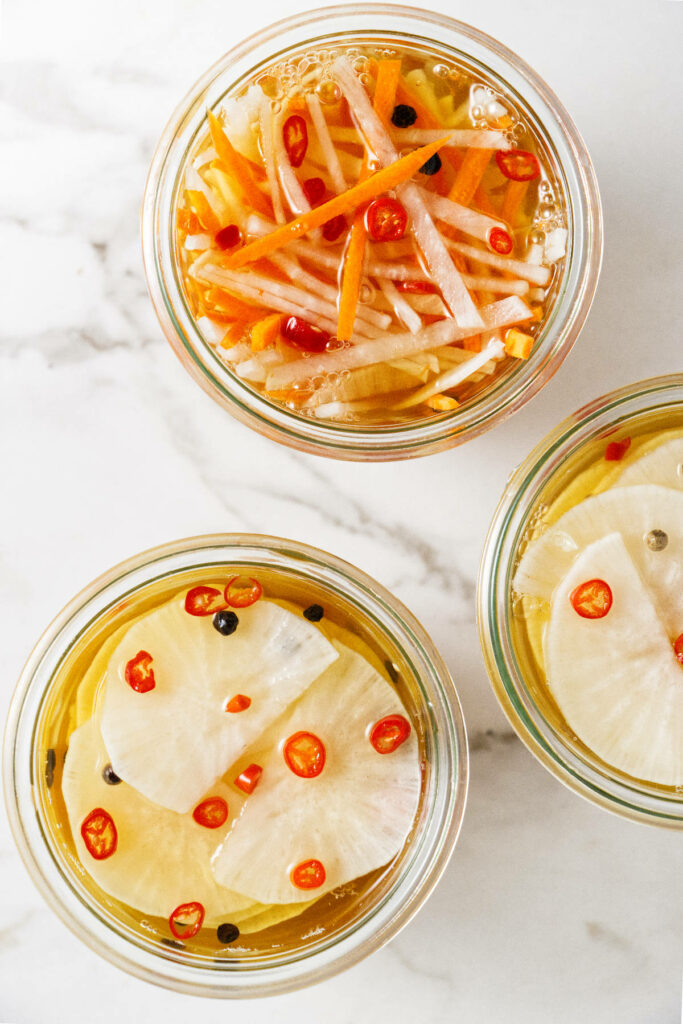
Pickled daikon radish is a super easy way to add major flavor to your meal!
Often called Japanese radish or winter radish, daikon is a type of radish that is cool and crunchy with a subtly sweet taste and a texture similar to other root vegetables.
It is commonly used in Asian cuisine and often combined with carrots to make a quick pickle for Banh Mi sandwiches (serve those sandwiches with our spicy cucumber salad). Overall, it’s our favorite way to enjoy daikon!
Sliced into matchsticks and infused in rice vinegar, daikon turns into incredible quick pickles with a sweet and snappy flavor. The tangy rice wine vinegar, mirin and mix of aromatics is crisp and refreshing with a medium heat level that will jazz up all sorts of main dishes.
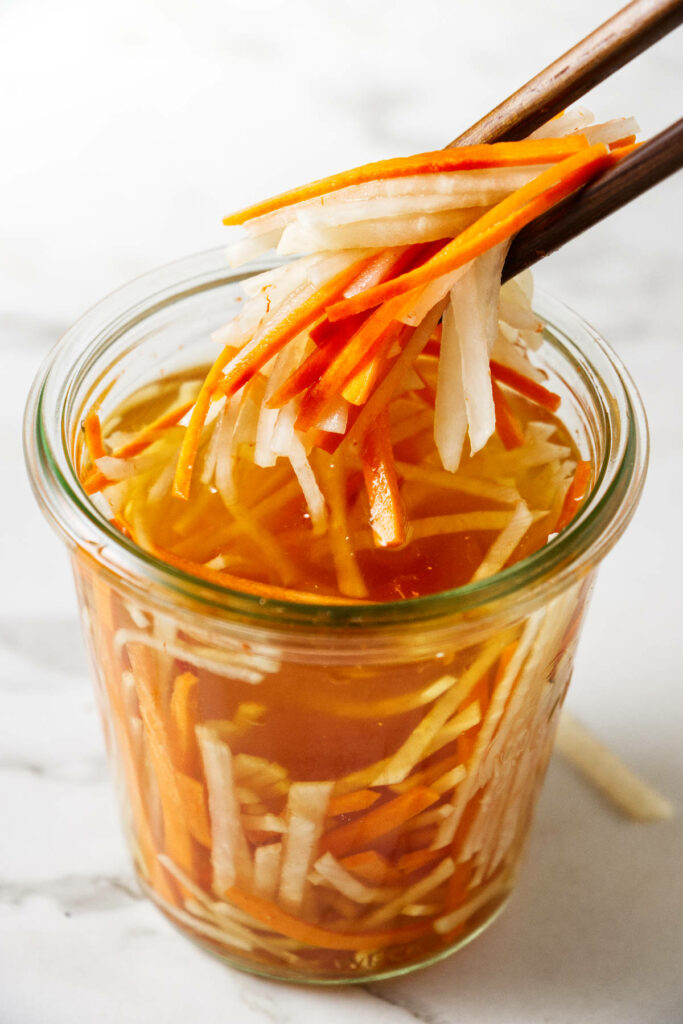
Why This Recipe Works
Our quick pickled daikon radish is similar to our pickled green beans and Pickled Watermelon Radish recipes but with a more intense flavor.
The addition of sweet sake, white vinegar, garlic cloves, soy sauce and red chili peppers to the pickling liquid creates a delicious medley that resembles the traditional way of making Japanese pickled daikon.
Here’s why you’ll love Japanese daikon radish:
- it’s simple to prepare
- daikon will elevate any dish
- the flavors and textures will not disappoint
The Ingredient List
The main pickling ingredient in our pickled daikon recipe is rice wine vinegar. Mirin and sugar in the pickling brine helps to offset the sour flavor of the vinegar, while aromatics infuse their own unique flavors.
Here’s what you’ll need to make this sweet pickled daikon:
- whole daikon radish
- large carrots (optional)
- rice wine vinegar
- mirin (sweet sake)
- water
- sugar
- garlic cloves, crushed
- soy sauce
- red chili pepper, sliced thin
Most larger grocery stores will carry these ingredients. If your store doesn’t stock them, you should be able to find daikon radish and the other ingredients at an Asian grocery store or Asian market.
How to Make Pickled Daikon
There are just a few simple steps required when making your own pickled daikon at home. Below is a look at the quick pickling process but be sure to scroll to the bottom of the page to view the printable recipe card.
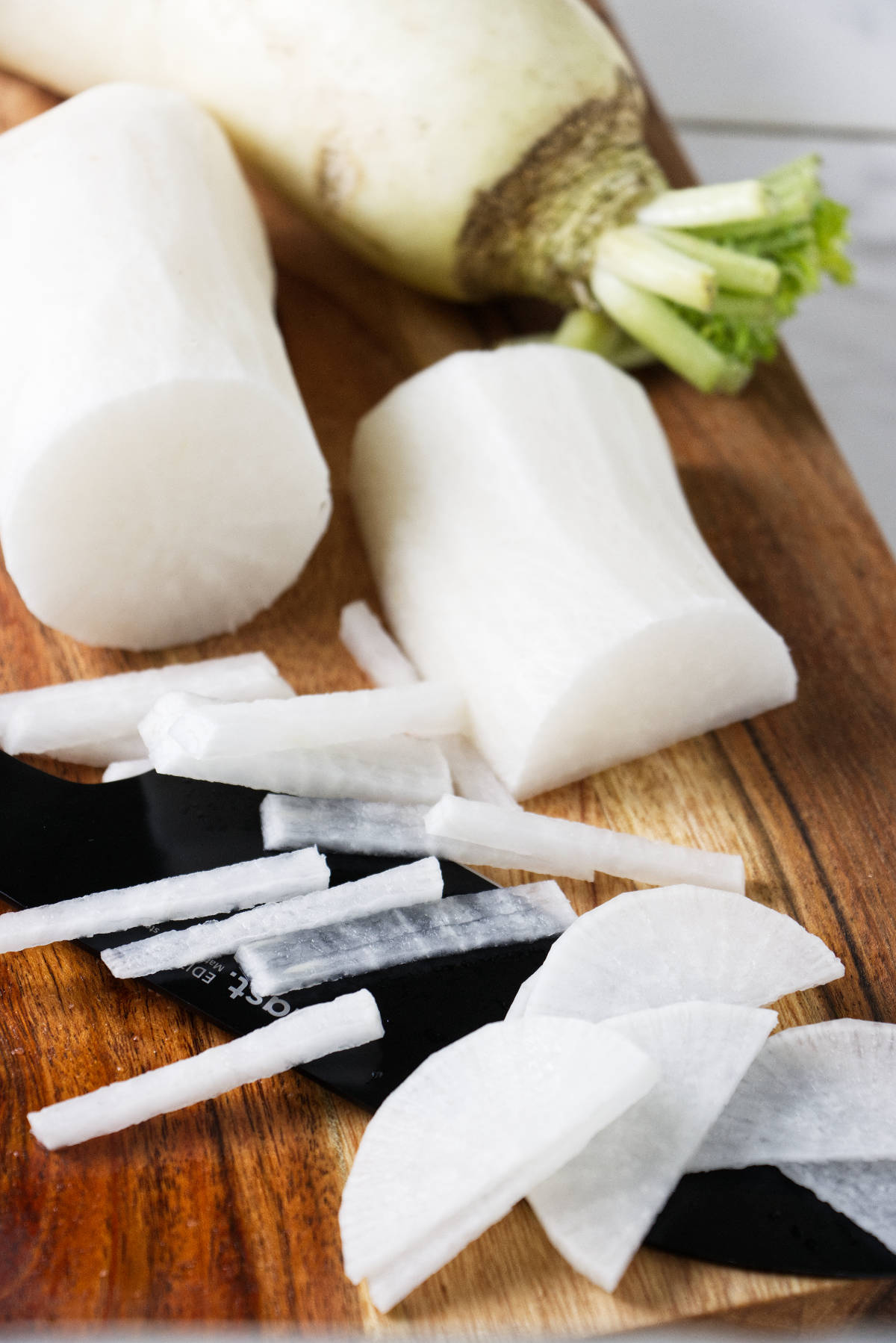
Peel the daikon radish and slice it into 1/4-inch circles or thin matchsticks. If using carrots, cut them in the same way.
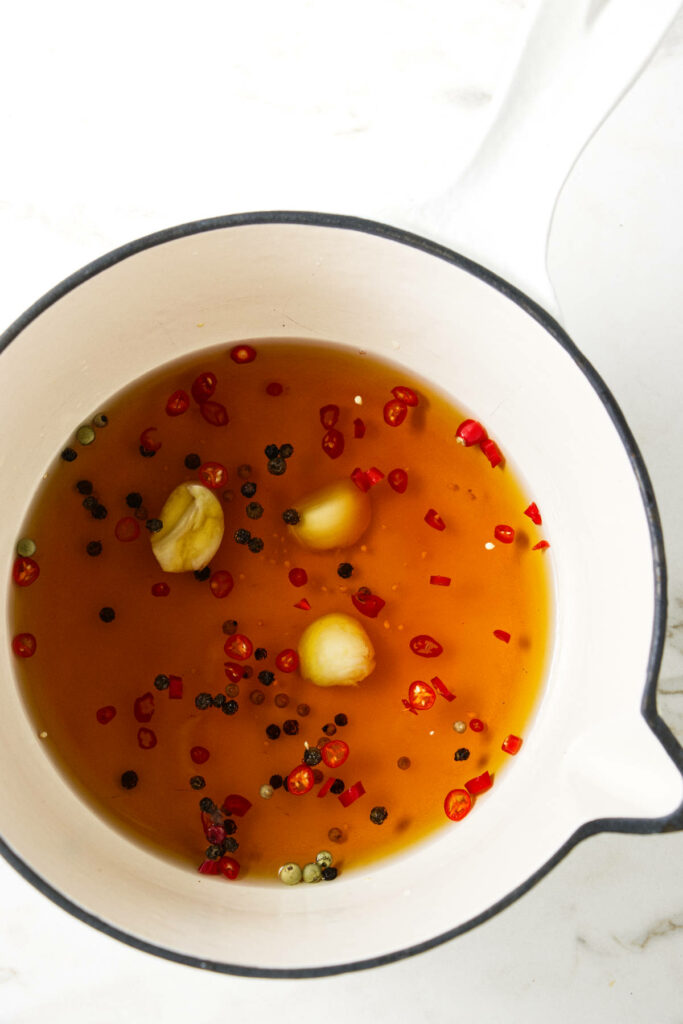
Place the daikon in a large bowl (heat-proof) or divided between mason jars. In a small saucepan, add the other ingredients and bring to a boil. Stir until the sugar dissolves.

Pour the hot pickling brine over the vegetable slices. When it cools to room temperature, seal the jars with a lid or cover the bowl and refrigerate for 8 to 12 hours.
Pro Tips for the Best Results
- The pickled daikon will get a stronger flavor the longer it sits in the vinegar mixture. If you let it sit too long and it picks up too much flavor, you can pour out the brine and store the veggies in a resealable bag. Make sure to push air out of the bag before sealing. This will help the daikon stay fresh and prevent it from drying out.
- You can store pickled daikon in an airtight container in the fridge for up to 4 to 6 weeks.
How to Use Pickled Daikon
Like other pickled radish recipes, there are so many different ways to enjoy pickled daikon! From Korean BBQ to spicy sushi shrimp stacks and your favorite Japanese meal, pickled daikon makes a simple side dish, condiment and topping.
Its snappy, sweet flavor is also delicious on its own. Here are a few dishes that you can enjoy pickled daikon with.
- Pork Yakisoba
- Japanese Cucumber Salad
- Sake Marinated Grilled Ribeye Steak
- Pineapple Chicken Curry Sandwich
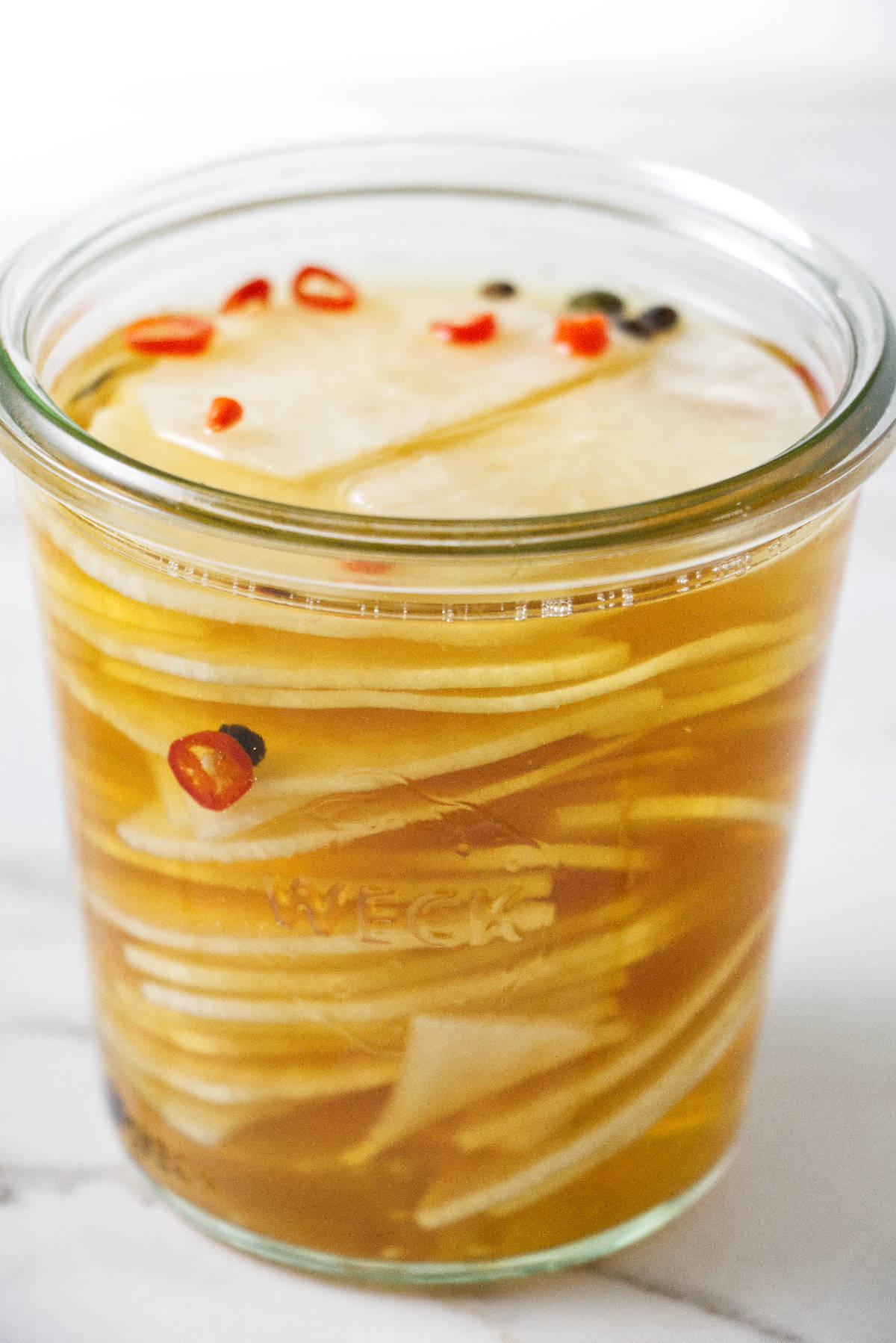
If you’re new to daikon, this quick pickled daikon radish recipe is the perfect way to try it out! It’s cool, refreshing and versatile.
More Condiment Recipes
- Peach Preserves
- Strawberry Rhubarb Jam
- Red Chili Sauce (Enchilada Sauce)
- Japanese Marinade
- 28 Essential Condiment Recipes
Helpful Tools
Some of the following are affiliate links. If you click on these links and purchase something, we may receive a small commission. You don’t pay any extra, but it will help us keep the lights on.
Some Other Recipes We Are Sure You Will Love
These Pickled Cucamelons are perfect for charcuterie boards, salads and gifting. Sweet and spicy, they have just the right amount of tang and acidity level that balances out rich cheese and meats. Cucamelons are also the cutest pickles ever, and they are sure to brighten up any meal.
Quick Pickled Red Onions are the best sandwich and salad topping! Pickling red onions transforms them into sweet, tangy morsels that add major flavor to all kinds of main meals. Best of all, these are super simple to make and might just become a new kitchen staple.
Our Spicy Crispy Chicken Sandwich is the best combination of flavors and textures. A crispy Panko chicken breast is pan-fried and served sandwich style, topped with a creamy chipotle aioli and crisp pickled red onions. It’s tender and juicy and each bite is amazing.
Pin this now to find it later!
Pin It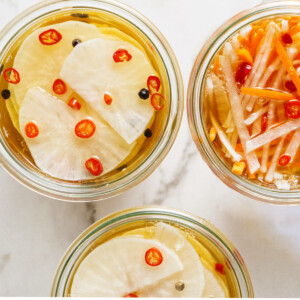
Pickled Daikon
If you make this recipe, please leave a star rating and comment.
Ingredients
- 1 daikon radish, 6 to 8 inch chunk
- 2 large carrots
- 1 cup rice wine vinegar
- ½ cup mirin, sweet sake
- ½ cup water
- ⅓ cup granulated sugar
- 3 garlic cloves, crushed
- 2 tablespoons soy sauce
- 2 long red chili peppers, sliced thinly
Instructions
- Peel the daikon and slice into 1/4 inch circles or thin matchsticks. Do the same with the carrots, if using. Place the daikon (and carrots if using) in a heat-proof bowl or some Mason jars.
- Add the rice wine vinegar, mirin, water, sugar, garlic cloves, soy sauce, and chili peppers to a saucepan and bring to a boil. Stir until the sugar dissolves.
- Pour the hot brine over the vegetable slices.
- When the brine cools down, place lids on the jars or cover the bowl and refrigerate for 8 to 12 hours.
Notes
- Store the pickles in an airtight container in the fridge for 4 to 6 weeks.
- The pickled daikon will get a stronger flavor the longer it sits in the brine. If it starts to pick up too much flavor, you can dump out the brine and store the veggies in a re-sealable bag (push the air out of the bag, so the daikon doesn't dry out).
Nutrition
Nutrition information is automatically calculated, so should only be used as an approximation.
 Like this recipe? Rate & comment below!
Like this recipe? Rate & comment below!This post was originally published on January 24, 2018.

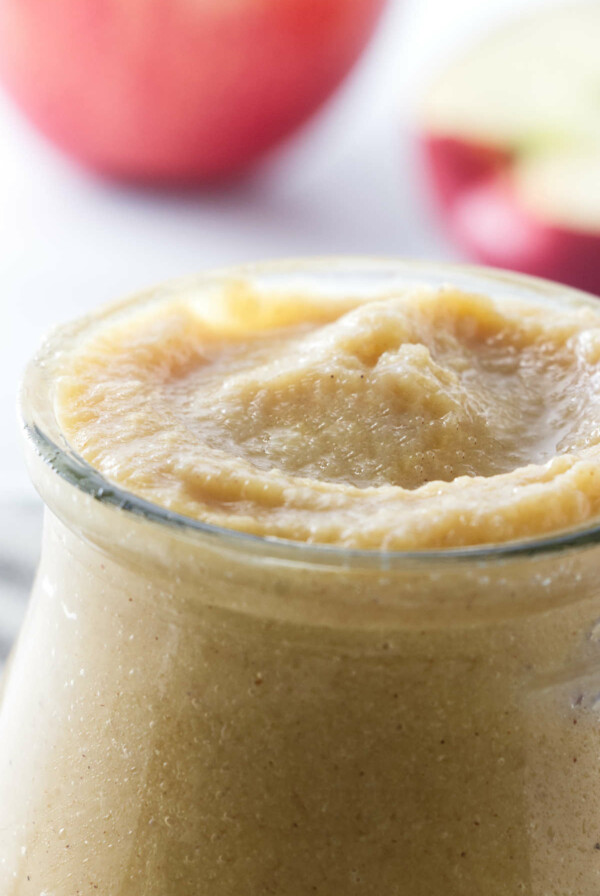
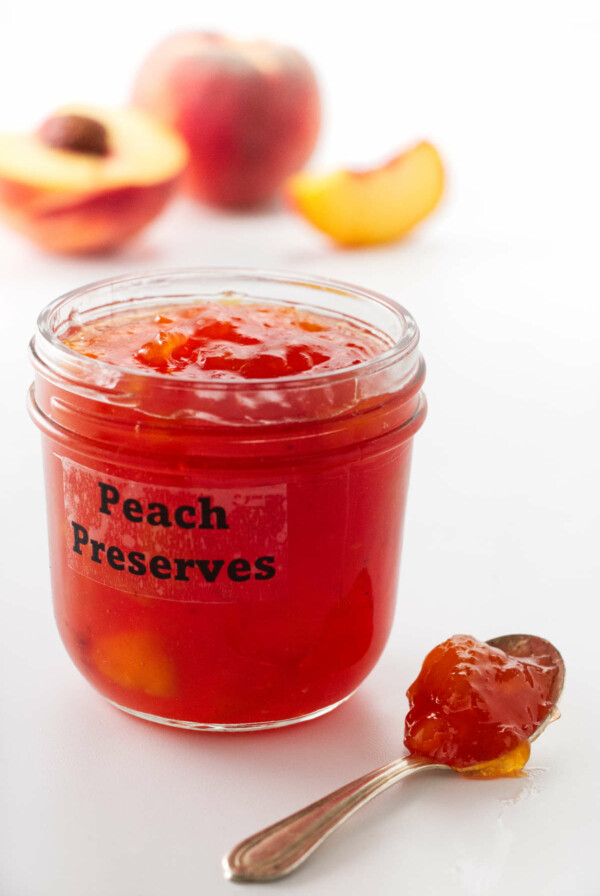
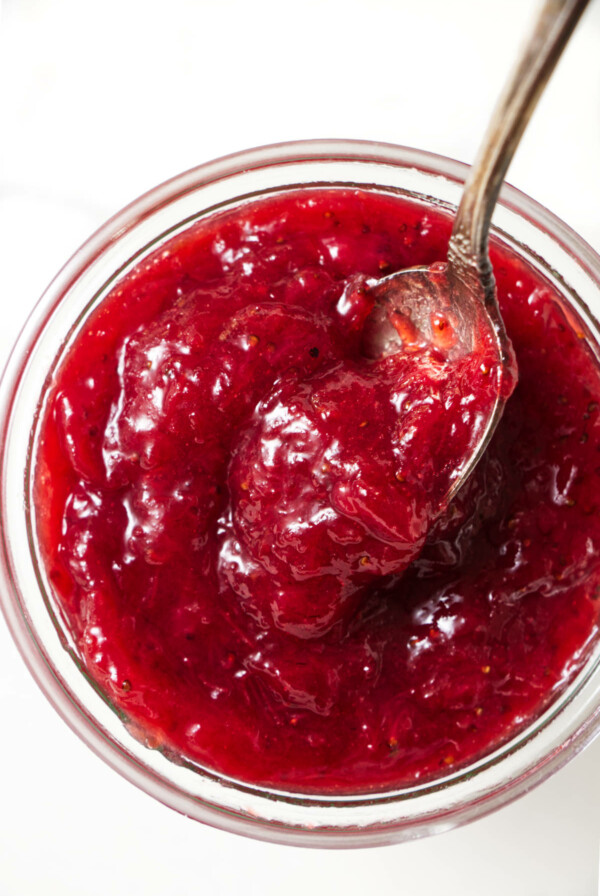
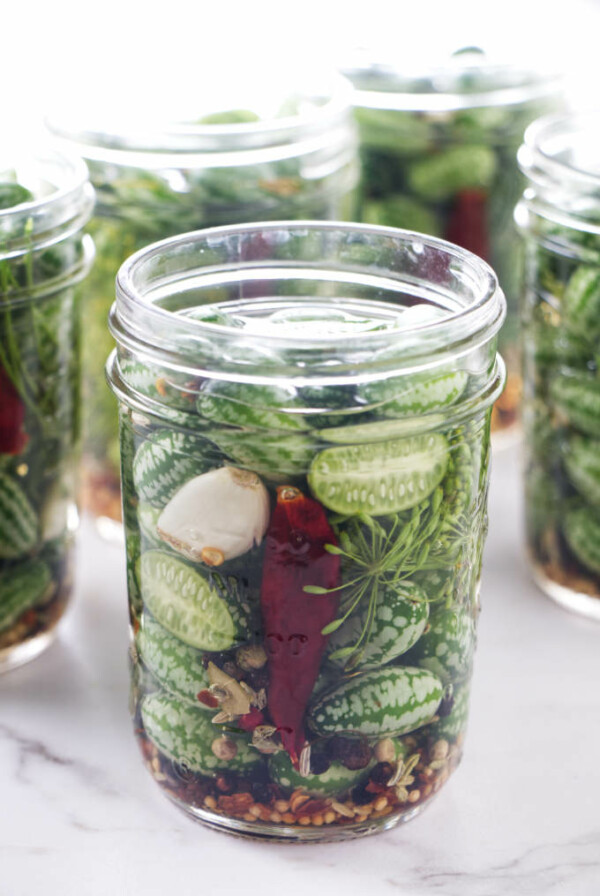










Thanks for the information. I have heard a lot about some of the health benefits of fermented food. Your point about using natural salt is a good one. I have switched over to pink Himalayan salt for everything, even at the table.
Thanks for the comment Jim, I have done the same thing and use Himalayan salt at the table as well.
What a great post! I’ve been reads loads of articles about how important fermented foods are to our diet, and the idea really makes sense. So your timing is perfect! Plus I’ll wager these have wonderful flavor! Thanks so much.
Thanks John, these really are fabulous tasting and make a great addition to salads